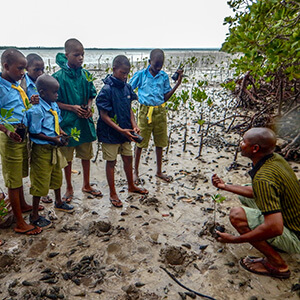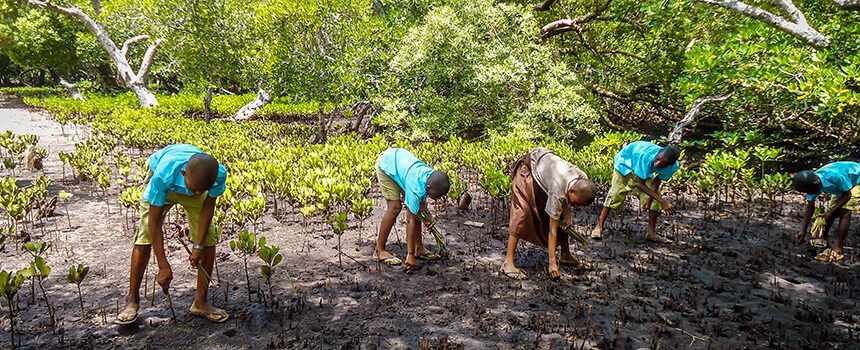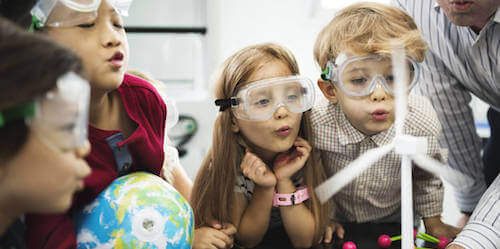 Mangroves: Habitat between land and the sea
Mangroves: Habitat between land and the sea
Protection and replanting of mangrove forests along Kenya’s coast
Mangrove forests are a unique ecosystem along tropical shores. For millennia they have been providing valuable ecosystem services to people and the environment. They stabilise the coast, purify the water and are a refuge and habitat for countless animal species. Mussels and barnacles stick to their branching fringes, fish lay their eggs between their roots, marine snakes and crocodiles lie in ambush for their prey, sea turtles find shelter and food in the undergrowth below the water. But also above the water line, branches, twigs and leaves of the mangroves provide a habitat and food for many animals, such as birds, climbing crabs and insects. The local people also profit from them: Mangrove forests are nurseries for edible fish, provide natural water filtration and are most of all a valuable defence against flooding and coastal erosion.
Necessity
Sustainable replanting of mangrove forests to conserve an endangered ecosystem in Kenya.
Activity
With the instruction of project staff, local school children plant endemic mangrove seedlings that have been raised at the project’s own tree nursery.
Countable effort
Number of seeds and seedlings that have been planted due to this good deed.
Result
Destroyed mangrove swamps are being re-forested and can serve as a habitat and food source to people and animals alike, as well as protecting the coast.
Systemic effect
The locals gain an awareness of the value of mangrove swamps and thus take action to protect them.
Background
Mangrove forests have continued to be lost over recent decades. The trees are cut down for fire wood, they have to make way for houses and resorts for tourists.
The mangroves are also effected by the pollution of the water with oil and pesticides. Both biodiversity and the local population increasingly suffer from the consequences. Protecting the existing mangrove forests and their long-term replanting are urgently needed to preserve these valuable habitats.
The good deed
This good deed makes it possible to plant mangrove seedlings in Mida Creek, a mangrove swamp within the nature and bird sanctuary Watamu in Kenya. Mida Creek is home to seven of the nine native Kenyan mangrove species. The seeds of the plants are collected and cultivated into seedlings in the project’s own nursery, in order to reforest the mangroves as close to their original state as possible. At regular intervals, project staff conduct ‘mangrove planting days’ together will local school children. Depending on the species and the local conditions, rather than seedlings, seeds are also planted directly. By getting the locals involved, this good deed will also help to educate them on the value of the mangrove forests and motivate the people on the ground to actively protect them.

AboutKenia
Nairobi
Capital
48 461 600
Number of inhabitants
1 516
Gross domestic product per capita per year
146
Human Development Index
In March 2017, the Kenyan government decided on a total ban on plastic bags. This puts Kenya in the vanguard of combating the contamination of the environment with plastic litter.
About the organization and further information
Association
Aktionsgemeinschaft Artenschutz (AGA) e.V.




